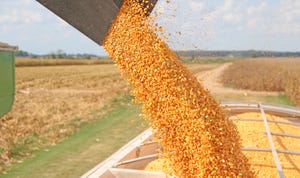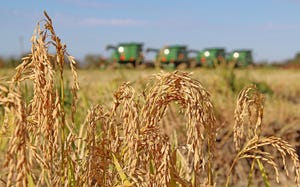February 11, 2021

Chad Render says all it took was a little help from his friends in the University of Arkansas System Division of Agriculture and the USDA-NRCS to point him toward new water-saving practices on his corn, rice and soybean farm near Pine Bluff, Ark.
Render, who averaged producing 11.5 bushels of corn per acre per inch of water in his contest field last year.Render, who finished in first place in the University’s “Most Crop Per Drop” Corn Irrigation Contest in 2020, talked about his experience in a video shown during the first-ever virtual Arkansas Soil and Water Education Conference Jan. 27.
 Render averaged producing 11.5 bushels of corn per acre per inch of water in 22020. (Staff)
Render averaged producing 11.5 bushels of corn per acre per inch of water in 22020. (Staff)
He and the first-place finishers in the Rice and Soybean Irrigation portions of the competition received cash prizes from the Arkansas Corn and Grain Sorghum Promotion Board, Ricetec and the Arkansas Soybean Promotion Board. The second- and third-place finishers in each category also received cash prizes.
“It doesn’t take that much effort when you have people with the University making it easy for us to do these practices like the Pipe Planner, the moisture sensors, the (surge) valves that y’all offer us,” said Render, who averaged producing 11.5 bushels of corn per acre per inch of water in his contest field last year.
“And once we try this, from my personal experience, I’m seeing benefits from less water usage and more yield,” he said. “At the end of the day I appreciate what y’all are doing, and the effect it is having on our bottom line.”
Render said he was introduced to the program by Scott Crabb with the USDA’s Natural Resources Conservation Service in Jefferson County. “He made it real simple for me to join in. We had good rainfall, and we monitored our waterings that we had on the corn.”
Curt Beaty with the Arkansas Cooperative Extension Service in Jefferson County and Greg Simpson, irrigation program associate with the University’s Rice Research and Extension Center near Stuttgart, also helped him with the contest field.
“When Greg comes out to do the yield trials, he’s super,” said Render. “He knows we don’t want to stop any more than we have to when we’re harvesting, but he makes it very simple. The guys who help us on the farm are top-notch. They make it easy for us.”
As the first-place finisher, Render received a $6,000 cash prize. Terry Smith, who farms in Greene County, finished second with 9.6 bushels of corn per acre per inch and received $3,000. Brandon Cain, who farms in White County, was third with 9.5 bushels per acre per inch and received $1,000.
Cody Fincher - Rice
Cody Fincher, who finished first in the Rice Irrigation Contest, says his primary goal when he entered the competition was to see how much water he could save on his farm near Dyess in Mississippi County, Ark.
 Fincher chose the right field and monitored it efficiently, according to Chris Henry, Extension irrigation specialist with the University of Arkansas. (Staff)
Fincher chose the right field and monitored it efficiently, according to Chris Henry, Extension irrigation specialist with the University of Arkansas. (Staff)
He averaged 8.7 bushels of rice per inch of water that went on the field and received a Ricetec hybrid seed credit worth $10,000. He said he learned patience was a virtue when it comes to irrigating his crops.
“The biggest thing I did was I managed it more closely; kept my eye on it,” he said. “I think I only turned the well on four times all summer. We caught a couple of rains here and there. Basically I made sure I didn’t lose any water on the bottom end, and I would let the field go as long as it possibly could.
“Had this field not been in the competition I would have started the well a little sooner, but I was trying to go as long as I could before I turned the well back on. I think that was key there. I got lucky and had a pretty good yield (240 bushels per acre).”
As is often the case with contests, Fincher said he believed field selection helped. “It was leveled on an 0.5-inch grade. And it doesn’t have the best drainage so I knew it would be a good fit for the contest.”
The field, which was cascade-irrigated on a technique similar to alternate-wetting-and-drying or AWD, did not have moisture sensors.
“Cody chose the right field and managed it efficiently in every way,” said Dr. Chris Henry, Extension irrigation specialist with the University of Arkansas System Division of Agriculture. Henry started the contest four years ago.
Fincher said he got a late start on the contest. “I think we were getting ready to water rice the following week. Mr. Greg (Simpson, irrigation program associate with the University of Arkansas’ Rice Research and Extension Center) came right on out and got me set up.”
Seth Tucker in Drew County finished second in the Rice Contest with an average of 6.7 bushels per acre per inch of water and received $3,000. Finishing third was Clint Boles in Cross County with 6.7 bushels per acre per inch of water. He received $1,000. Tucker harvested 203 bushels per acre and Boles 211 bushels per acre on their fields.
Jeremy Weideman - Soybean
Jeremy Weideman, a producer from Clay County who finished first in the Soybean Irrigation Contest with an average of 4.3 bushels per inch of water, said he also learned his crop could go longer without irrigation.
“We’ve been told we’re overwatering, and I’d say so after what I did this year,” he said, referring to his finishing first, which earned him a $6,000 cash prize from the Arkansas Soybean Promotion Board. “But it’s still a matter of reading the moisture sensors and trusting them and using them to determine when to water.
“Obviously, and Greg (Simpson) stressed this to me from the start: Yield isn’t everything – irrigation timing is important.”
Weideman used three Watermark moisture sensors installed at depths of 6, 12 and 18 inches in the contest field and checked them regularly to determine when to irrigate. He planted his soybeans June 11 and watered three times in three months, achieving an irrigation efficiency of 4.3 bushels per inch.
“I pushed the irrigation as far as I could,” he said. “We caught some rains, but I waited as long as I could, and I’m amazed I could do that with that little amount of water. I’m encouraged to try that with other fields.
“I’ve proved you can save a lot of water, and that’s what I’m going to use going forward – to try to use less water,” he noted.
Lincoln County producer John Allen McGraw finished second with 4.2 bushels per inch of water per acre, and Ryan Sullivan, who farms with his father, Mike Sullivan; and cousins, Scott and Gavin Sullivan, in Mississippi County, finished third with 4.1 bushels per inch of water.
Weideman averaged 64 bushels per acre in his soybean field while McGraw averaged 76 bushels per acre and the Sullivans 99 bushels per acre in their fields.
“The competition focuses on maximizing yield by maximizing water use efficiency,” said Henry, who is an associate professor and water management engineer with the University of Arkansas. He began the contest three years ago.
“The Irrigation Yield Contest is a safe place to try new sustainable technologies and strategies,” said Simpson. “There is value in these technologies for water savings and sustainability, certainly, but also for labor savings and improved net returns.”
To learn more about irrigation and how to get involved with the 2021 Most Crop Per Drop contest visit www.uaex.edu/irrigation.
About the Author(s)
You May Also Like






